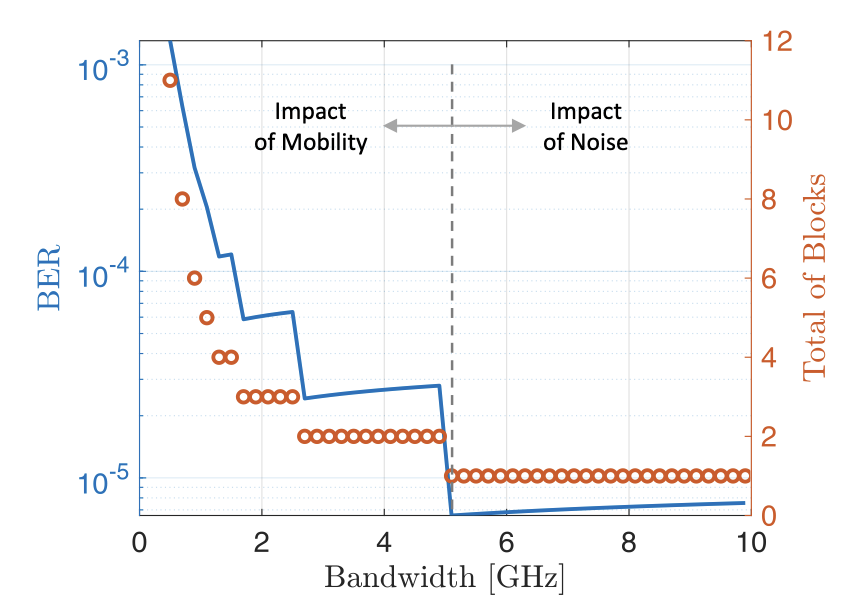Internet of Bio-Nano-Things


Institutions
- TU Berlin
- Friedrich-Alexander-University Erlangen-Nuremberg
- TU Munich
- TU Dresden
- TU Darmstadt
- University of Lübeck
- DFKI Kaiserslautern
Team @ TKN
Funding
- BMBF

Project Time
- 01/2024 - 12/2026
Homepage
Description
Conventional wireless communication systems are based on radio frequency waves. Even though perfectly suited for classic telecommunication tasks, communicating nodes of nano- or micro-scale size, possibly interfacing with biological cells, and/or operating in challenging environments (e.g., liquids) need to employ alternative communication paradigms and technologies like molecular communication. In the IoBNT project, we will investigate and develop a communication system targeting precision medicine and microscale industrial applications. The IoBNT is tailored to coordinate monitoring and actuation in the human body through a communication platform that also connects nanodevices and external gateways. The IoBNT will integrate radio, ultrasonic, and molecular communication schemes in the context of 6G+ wireless networks. The methodological spectrum of the project comprises theoretical modeling, communication- and information-theoretical analysis, computer simulations, and proof-of-concept experiments of integrated IoBNT systems. Expected outcomes include the communication-and information-theoretical characterization of integrated the in-body communication channels, methods and algorithms for transmission, sensing, estimation, and detection in molecular communication systems, simulation tools for integrated IoBNT systems, and testbeds for early experimental validation of investigated concepts and developed solutions. The goal of the project is the research and development of an IoBNT platform to interconnect the biologic domain of the human body with the digital domain of 6G+ networks. Besides, we will develop concepts and technology needed for future joint projects with partners in life sciences such as synthetic biology, molecular biology, medicine, and biochemistry. This will attract industry in Germany to move into this rapidly growing and innovative domain, strategically positioning them to become technology leaders for 6G+ wireless networks.
Selected Publications
 Jorge Torres Gómez, Jennifer Simonjan and Falko Dressler, "Low-Complex Synchronization Method for Intra-Body Links in the Terahertz Band," IEEE Journal on Selected Areas in Communications, 2024. (to appear)
[BibTeX, PDF and Details...]
Jorge Torres Gómez, Jennifer Simonjan and Falko Dressler, "Low-Complex Synchronization Method for Intra-Body Links in the Terahertz Band," IEEE Journal on Selected Areas in Communications, 2024. (to appear)
[BibTeX, PDF and Details...] Jorge Torres Gómez, Jorge Luis González Rios and Falko Dressler, "Electric Circuit Representation of the Human Circulatory System to Estimate the Position of Nanosensors in Vessels," Elsevier Nano Communication Networks, vol. 40, pp. 100499, July 2024.
[DOI, BibTeX, PDF and Details...]
Jorge Torres Gómez, Jorge Luis González Rios and Falko Dressler, "Electric Circuit Representation of the Human Circulatory System to Estimate the Position of Nanosensors in Vessels," Elsevier Nano Communication Networks, vol. 40, pp. 100499, July 2024.
[DOI, BibTeX, PDF and Details...]- Roya Khanzadeh, Stefan Angerbauer, Jorge Torres Gómez, Andreas Springer, Falko Dressler and Werner Haselmayr, "QL-based Adaptive Transceivers for IoBNT Communications," Proceedings of 8th Workshop on Molecular Communications (WMC 2024), Oslo, Norway, April 2024. [BibTeX, Details...]
- Lisa Y. Debus, Pit Hofmann, Jorge Torres Gómez, Frank H. P. Fitzek and Falko Dressler, "Synchronized Relaying in Molecular Communication: An AI-based Approach using a Mobile Testbed Setup," Proceedings of 8th Workshop on Molecular Communications (WMC 2024), Oslo, Norway, April 2024. [BibTeX, Details...]
 Lisa Y. Debus, Pit Hofmann, Jorge Torres Gómez, Frank H. P. Fitzek and Falko Dressler, "Reinforcement Learning-based Receiver for Molecular Communication with Mobility," Proceedings of VDE Workshop Biosignals, Göttingen, Germany, February 2024.
[BibTeX, Details...]
Lisa Y. Debus, Pit Hofmann, Jorge Torres Gómez, Frank H. P. Fitzek and Falko Dressler, "Reinforcement Learning-based Receiver for Molecular Communication with Mobility," Proceedings of VDE Workshop Biosignals, Göttingen, Germany, February 2024.
[BibTeX, Details...] Lisa Y. Debus, Pit Hofmann, Jorge Torres Gómez, Frank H. P. Fitzek and Falko Dressler, "Reinforcement Learning-based Receiver for Molecular Communication with Mobility," Proceedings of IEEE Global Communications Conference (GLOBECOM 2023), Kuala Lumpur, Malaysia, December 2023, pp. 558–564.
[DOI, BibTeX, PDF and Details...]
Lisa Y. Debus, Pit Hofmann, Jorge Torres Gómez, Frank H. P. Fitzek and Falko Dressler, "Reinforcement Learning-based Receiver for Molecular Communication with Mobility," Proceedings of IEEE Global Communications Conference (GLOBECOM 2023), Kuala Lumpur, Malaysia, December 2023, pp. 558–564.
[DOI, BibTeX, PDF and Details...]

